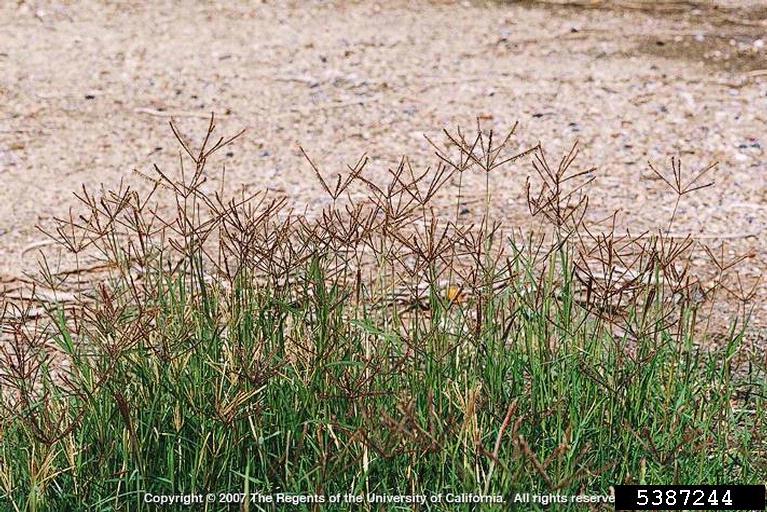 Common bermudagrass (Cynodon dactylon) is a mat-forming perennial that can be found just about anywhere in the southeastern US – from roadsides to production fields. This weed is very well adapted to the South and persists in areas with a variety of soil textures, soil pH, and fertility levels. Although common bermudagrass can be beneficial in many environments, it can make peanut harvest difficult, if not impossible. This makes control of common bermudagrass a priority for any peanut producer.
Common bermudagrass (Cynodon dactylon) is a mat-forming perennial that can be found just about anywhere in the southeastern US – from roadsides to production fields. This weed is very well adapted to the South and persists in areas with a variety of soil textures, soil pH, and fertility levels. Although common bermudagrass can be beneficial in many environments, it can make peanut harvest difficult, if not impossible. This makes control of common bermudagrass a priority for any peanut producer.
Being a perennial, this plant stores a tremendous amount of energy in the stolons (above ground stems) and rhizomes (below ground stems), making it capable of regrowth after most herbicide applications. Previous research has shown that a single application of most herbicides, even high rates of glyphosate, will not sufficiently control this weed. Considering that peanut producers must rely on either fluazifop (Fusilade® DX) or clethodim (Select® 2 EC), in-season control of common bermudagrass can be exceedingly difficult. With this in mind, we conducted a trial examining how these herbicides could be used to maximize control of common bermudagrass. Experiments were conducted in a neglected pasture with a solid stand of common bermudagrass. No peanuts were planted and no tillage was performed. This was done to maximize weed competitiveness. Therefore, the results presented below could be considered a “worst case scenario.” Fusilade® DX at 12 fl.oz./A (fluazifop 2 lb ai/gal) was compared to Select® 2EC at 16 fl.oz./A (clethodim 2 lb ai/gal). Applications began on May 21 and a second application was made either 14 or 28 days later. Crop oil (1 gal per 100 gal) was mixed with all herbicides. The sprayer was calibrated to 20 gallons per acre to ensure adequate spray coverage. Plots were evaluated at 1 week intervals to determine herbicide performance.
For the first 4 weeks after application, the Fusilade and Select applications looked very similar. Neither herbicide provided 100% brown-out of the common bermudagrass, but both provided over 90% control. However, by week 5, control from the single application of either product began to rapidly decline and control was 0% by 10 weeks (Table 1). As expected, one application of either herbicide was not sufficient to provide season-long control and neither herbicide performed differently than the other. However, when repeat applications were made, control was significantly better. At 7 weeks after application, the repeat applications were providing greater than 90% control for both products. By 10 weeks after application, separation between Fusilade and Select became clear. At 10 weeks, two applications of Fusilade was providing 64-74% control, while two applications of Select ranged between 32-35% control. Interestingly, no differences were observed with the repeat applications, regardless if they were applied 14 or 28 days apart. This indicates that the repeat application, not the timing, is the essential part of common bermudagrass control. However, it has been my experience that waiting too late on the followup treatment can reduce control. If the second application is delayed until the bermudagrass is back to 100% green, control will follow the same pattern of a single application.
Though Fusilade provided good control of common bermudagrass, some would say that 64-74% control is marginal at best. In that case, additional applications could be made. The Fusilade® DX label allows up to 48 oz/A/yr to be applied, as long as the last application doesn’t occur within 40 days of harvest. Additionally, other research showed that applying Fusilade with the fungicides Abound®, Headline®, or Bravo Weather Stik®, did not decrease control of common bermudagrass. Therefore, Fusilade could be tank-mixed with fungicides allowing growers the efficiency of combining their fungicide and herbicide sprays. However, a note of precaution is needed. Growers should note that though Fusilade is highly effective on perennial grass weeds (common bermudagrass, johnsongrass, etc), it can struggle with certain annual grasses (crabgrass, goosegrass, etc) if they get too big prior to application. The Fusilade® DX label suggests a 12 oz/A rate for crabgrass that is 1-2” in height while the Select® 2EC label suggest 6-8 oz/A on 2-6” crabgrass. This should be a consideration if you plan to use Fusilade in your peanut weed control programs.
- The How and Why of Preemergence Herbicide Incorporation for Row Crops - April 28, 2017
- Using Dicamba on Dicamba-Tolerant Crops - March 3, 2017
- Managing Dicamba Drift when using New Dicamba Resistant Cotton Varieties - January 27, 2017
